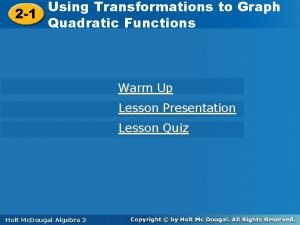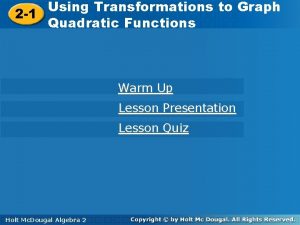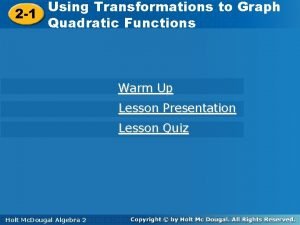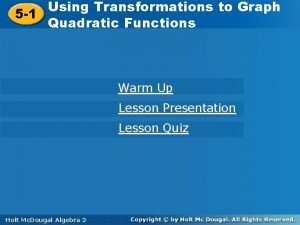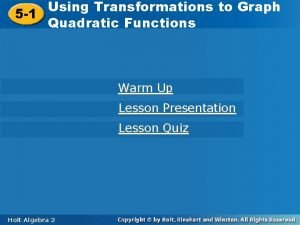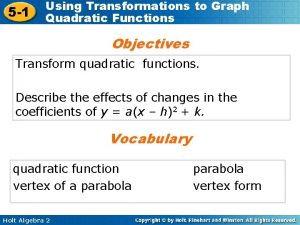5 1 Using Transformations to Graph Quadratic Functions





- Slides: 5

5 -1 Using Transformations to Graph Quadratic Functions Warm Up 1. ) For the function, evaluate f(– 2). f(x) = 2 x 2 – 5 x + 1 2. ) Translate f(x) = |x| so that the vertex is at (4, – 2). Then sketch a graph. LEARNING GOALS – LESSON 5 - 1 5. 1. 1: Use Transformations to Graph Quadratic Functions 5. 1. 2: Transform x 2 functions (stretch, compression, translate, and reflect). 5. 1. 3: Use transformation descriptions to write quadratic function in vertex form (y = a(x – h)2 + k). 5. 1. 4: Apply quadratic transformations to real-life situations. A ________function is a function that can be written in the form of f(x) = a (x – h)2 + k. x y = x 2 -2 Notice that the graph of the parent -1 function f(x) = x 2 is a bell-shaped curve called a __________. 0 1 2 Example 1: Graphing Quadratic Functions Using a Table A. Graph g(x) = –x 2 + 6 x – 8 using a table. x – 1 1 3 5 7 g(x)= –x 2 +6 x – 8 (x, g(x))

5 -1 Using Transformations to Graph Quadratic Functions When identifying h and k be sure to remember this general form below before deciding if they are negative or positive. f(x ) = a ( x – h )2 + k You can also graph quadratic functions by applying transformations to the parent function f(x) = x 2. Translations of Quadratic Functions Horizontal Shift Right when h is pos. Left when h is neg. Vertical Shift Up when k is pos. Down when k is neg. Horizontal Stretch/Compression Stretch when b is bigger than 1 Compression when b is smaller than 1 Reflection Across the x-axis Reflection Across the y -axis Vertical Stretch/Compression Stretch when a is bigger than 1 Compression when a is smaller than 1 This lowest or highest point is the _______of the parabola. The vertex of the parabola is (h, k)

5 -1 Using Transformations to Graph Quadratic Functions Example 2: Translating Quadratic Functions Use the graph of f(x) = x 2 as a guide, describe the transformations and then graph each function. A. g(x) = (x – 2)2 + 4 Step 1: Identify h and k and locate the new vertex. Step 2: Starting with the new vertex plot the “general shape” of the parent function. Use the graph of f(x) = x 2 as a guide, describe the transformations and then graph each function. B. g(x) = (x + 2)2 – 3 C. g(x) = x 2 – 4

5 -1 Using Transformations to Graph Quadratic Functions Example 3: Reflecting, Stretching, and Compressing Quadratic Functions Using the graph of f(x) = x 2 as a guide, describe the transformations and then graph each function. A. g(x) = ¼ x 2 B. g(x) =(2 x)2 C. g(x) =(½x)2 D. g(x) = - ⅓ x 2

5 -1 Using Transformations to Graph Quadratic Functions Example 4: Writing Transformed Quadratic Functions Use the description to write the quadratic function in vertex form. A. The parent function f(x) = x 2 is vertically compressed by a factor of ⅓ and then translated 2 units left and 5 units down to create g. B. The parent function f(x) = x 2 is vertically stretched by a factor of 2 and then translated 2 units right and 4 units down to create g. C. The parent function f(x) = x 2 is reflected across the x-axis and translated 5 units left and 1 unit up to create g. D. The parent function f(x) = x 2 is reflected across the y-axis and translated 5 units up and compressed horizontally by a factor of ½ to create g. Using f(x) = x 2 as a guide, describe the transformation of each function. A. f(x) = - ( x + 5 )2 B. f(x) = ¼ x 2 + 2 C. f(x) = (3 x)2 + 1 Example 5: Scientific Application A. The average gas mileage m in mpg for an average sedan is modeled by msed(s) = -0. 01(s – 50)2 + 25, where s is the car’s speed in mph. The average gas mileage for an SUV is modeled by msuv(s) = -0. 01(s – 50)2 + 15. What kind of transformation describes this change, and what does this transformation mean?
